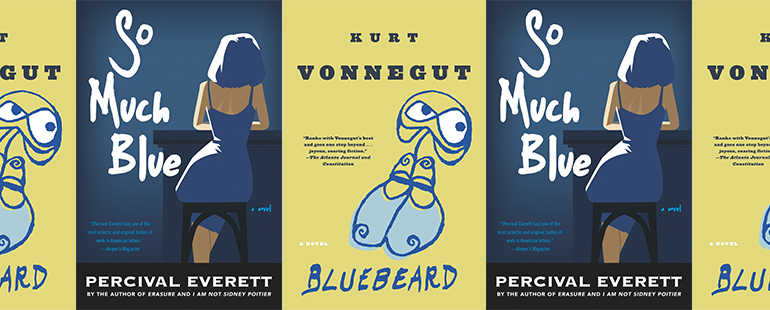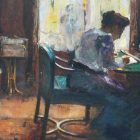Abstraction and Legacy in Bluebeard and So Much Blue

In his 1987 novel, Bluebeard, Kurt Vonnegut roughly modernizes the French classic fairytale of the same name. In it, the narrator, an Armenian-American painter named Rabo Karabekian, chews much on the dilemma of art’s purpose and worth. Having apprenticed under a famous commercial illustrator named Dan Gregory—another Armenian, who Americanized his name from Gregorian—Rabo develops keen if not unmatchable mimetic technique, but ultimately betrays his master by becoming a founding member of abstract expressionism. Rabo, while a minor figure, pals around and funds early projects by fictitious and real artists, such as Mark Rothko and Jackson Pollock. Ironically, Rabo’s most famous work, a line of eight 8×8 foot canvases titled “Windsor Blue Number Seventeen,” self-destructs as the paint peels away, leaving the canvases bare. This gaff becomes Rabo’s memorable footnote in the abstract expressionist movement.
Over the course of the novel, Rabo reveals that after taking the Windsor Blue canvases back from the corporate headquarters on Park Avenue where they were once prominently displayed in the lobby, he has them re-primed and labors over a new realist masterpiece; the work, we learn, remains tightly locked in a potato barn on his property in the Hamptons. “Right after my wife died,” Rabo notes, “I personally nailed the doors at one end shut from the inside with six-inch spikes, and immobilized the doors at the other end on the outside, from top to bottom, with six big padlocks and massive hasps.” Constant allusions to the contents of the potato barn serve as a source of chronic tension throughout the novel, a kind of running joke that doesn’t reach its full punchline until Rabo brings his autobiography to its final chapters.
Percival Everett’s So Much Blue (2017) borrows much of Vonnegut’s architecture. Like Vonnegut, Everett cycles in brief sections between the present and multiple past threads, and builds suspense using the same central device: a giant canvas in a foaling barn, locked away for no one, except his artist protagonist, Kevin Pace, to see. Both novels are first-person fictional autobiographies about painters haunted by mass atrocities—for Rabo, the Armenian Genocide and the Holocaust; for Kevin, the Salvadoran Civil War. The secrecy of the paintings is central to the arc and conclusion of both works but also serves as a jumping-off point for larger reflections on the capitalization of art. Kevin hears rumor his painting is already being bid on sight unseen; Rabo eventually decides to open up his house as an art museum, the potato barn being its main attraction. Through these structural similarities, Everett brings his thoughts on abstract art into conversation with Vonnegut: Rabo chooses to paint over his most famous abstract work after it has decayed in the creation of a work of realism; in So Much Blue, Everett adds another layer atop the surface, returning the canvas to one of abstraction.
“There is a cruelty in abstraction,” Kevin says. “It cuts into flesh. It relies on our fear of mortality for its meaning. The way it disturbs, distresses is meant to undermine some illusion of duration, of time controlled, even simply perceived.” Every novel, by definition executing manipulations that slow or speed up time, must grapple with this illusion. Bluebeard, an elderly artist’s autobiography, carries its fear of mortality in Rabo’s attempts to control the representation of a historic moment in time in painting a realist work. Everett, using Kevin’s views about his secret painting, suggests, however, that any level of control is impossible, even if, like Vonnegut, he doesn’t try to untangle the achronological pull of memory. The patterned shuffle of narrative threads, he seems to say, is a calculated magic trick, one perhaps simple enough to map, but difficult to fully comprehend. There will always be too many gaps to see anything more than a small fragment of the whole picture, even if there are still enough knots to get a sense of the shape. The same technique yields two dramatically different paintings.
After decades of promoting abstract expressionism, Rabo’s final work is a precise recreation of where he stood at the end of World War II. He describes it in intricate detail:
We were standing on the rim of a beautiful green valley in springtime. By actual count, there were five thousand, two hundred and nineteen people on the rim with us or down below. The largest person was the size of a cigarette, and the smallest a flyspeck. There were farmhouses here and there, and the ruins of a medieval watchtower on the rim where we stood. The picture was so realistic that it might have been a photograph.
The weight of global tragedy, the millions killed, starving, and displaced, is beyond abstraction. If abstract expressionism is a reaction to the worldwide horrors of the early twentieth century, Vonnegut here attempts to pan the camera back to the tragic realities of warfare. Everett’s protagonist, on the other hand, is less specific about the details of his massive work. Kevin reflects, “Abstract as it was, it was essentially a time line, simple as that, but time didn’t move along it, there were no intervals, nothing changed, accelerated, or stopped.” Everett ends with a wave of emotion and color, while Vonnegut eventually returns to work that is hyper-detailed and commercial. Kevin’s musings on his art complicate and challenge those of Rabo: Kevin doesn’t expect his work to contain a central message or to have a handle on its larger meaning. Similarly, Everett’s goal of an abstract novel might be impossible given the taxonomy of the genre itself—how does one decide when a novel is no longer a novel?—but it is also at odds with Vonnegut’s more pseudo-mathematical approach. Known for graphing the shapes of archetypical stories, Vonnegut argued “the shapes of stories could be fed into computers,” and mapped them along a Y-axis of good to ill-fortune and an X-axis from beginning to end. Vonnegut seemingly held to the idea that the equation of any novel could be solved; Everett takes the same equation, unravels it, and comes to a more nebulous conclusion.
In a recent interview with The White Review, Everett said, “I would like to make an abstract novel, but I don’t know how to do it. I’m always trying to do it, but I haven’t done it yet. I think every novel is experimental. The term is vacuous. A literary writer does not know what she or he is doing once started. So, that’s an experiment. If they use the word ‘innovative,’ that’s even worse.” Everett is a masterful technician and diligent reader. Even if every novel is an experiment, the well-read writer inherently recognizes that everything’s been done before and so there will always be points of influence and comparison; “You have to know the rules to break the rules” has always struck me as having a flawed premise—“breaking” the rules is so often a matter of merely following a different set. I imagine that’s part of Everett’s disdain for the term “innovative.” To be dubbed “innovative” suggests that neither the author nor the critic has done their homework. Vonnegut and Everett, even if commodifying art through disparate philosophies, would never expect their work to function in a vacuum.
Feeling his old age, Rabo asks his readers, “Is there nothing I’ve done which will outlive me, other than the opprobrium of my first wife and sons and grandchildren?” If art is a simple grasp at immortality, this kind of intergenerational playful borrowing is one means of survival. I’ve often heard Everett referred to as a literary cowboy, but if the suggestion is that his work is wild and unpredictable, then we must also respect all the more that the sense of controlled chaos is coming out of the author’s close study of literature, visual art, and philosophy. Everett’s allusions to Bluebeard are neither simple homage nor shots fired, but rather an exchange of ideas on aesthetics and the value of art raised through two parallel protagonists confronting the lasting consequences of their legacies.
This piece was originally published on April 1, 2021.



